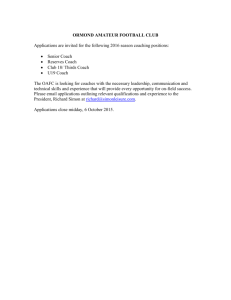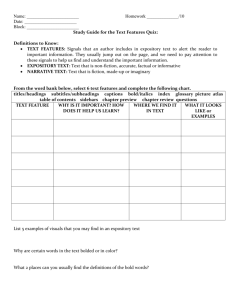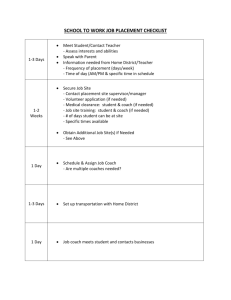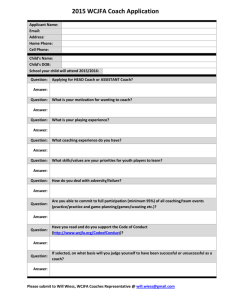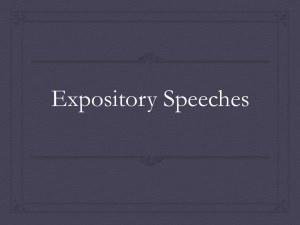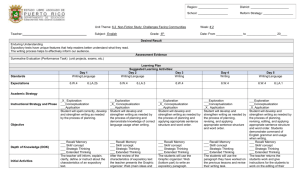Informative Speaking
advertisement
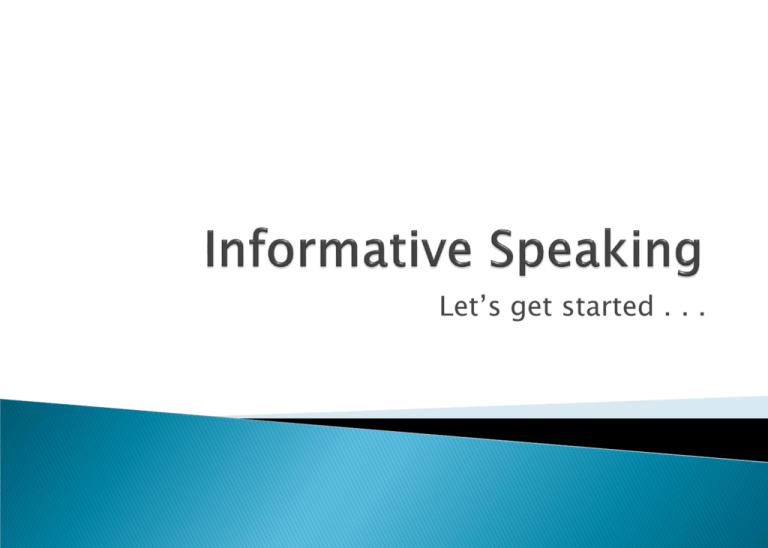
Let’s get started . . . An informative speech communicates knowledge and understanding about a process, an event, a person or place, an object, or a concept. Informative speakers share what they know or have researched to familiarize an audience with a topic an audience wants or needs to understand. Expository Speech – gives information about a specific topic Process speech – explains how to do something, how to make something, or how something works Select a topic you are interested in and know something about Expository Examples: Cliff Dwellings of the Anasazi Cartoon images in American Pop Culture Clothing of the 1700’s in the U.S. Process Speech Examples: How to use a power drill How to make origami flowers How to prepare healthy snacks Your general purpose is to inform your audience. Your specific purpose relates to your topic and to specific information you want to convey. For an expository speech, you might state your specific purpose as “I want to explain the three major steps in the evolution of the computer.” For a process speech, you could state your specific purpose as “I want to explain how to perform a soccer-style place kick.” The more convincingly you can show your listeners that you know about your topic, the more likely they are to pay attention and to remember what you say. To locate more information, use library information, credible Internet sources, and interviews with knowledgeable people. ALWAYS CITE YOUR SOURCES! Your introduction should: 1. attract the audience’s attention 2. focus attention on the subject 3. gain the audience’s goodwill There are several ways to organize the body of your speech: Chronologically – details and events in the order in which they occur in time. This method is good for informing about histories of topics In topical order, a topic is broken down into its parts and then arranged in an order determined by the speaker and stated in the specific purpose like, “I want to explain the three major types of extrasensory perception.” I. One type is telepathy 2. A second type is clairvoyance 3. A third type is precognition Climatic order arranges items according to their order of importance, usually starting with the least important and ending with the most. The specific purpose could be, “I want to explain three requirements for being a good football coach. 1. A good coach recognizes raw talent. 2. More important, a good coach understands the mechanics of the sport. 3. Most importantly, a good coach must be able to motivate a player to do his best. In cause and effect order, information is arranged to show causes or conditions and the effects or results of those conditions. 1. 2. 3. Specific purpose: “I want to explain (fill in the blank).” This happens So this happens And the result is this Consider who you are speaking to and their level of familiarity with the topic you are speaking about. Avoid using technical details and terms that are meaningful only to an expert You can use a number of methods and devices to help your audience understand and remember the information you are presenting. Mnemonic Devices help the memory by providing easy-to-remember associations. Example: H. O. M. E. S. (to remember the names of the five great lakes: Huron, Ontario, Michigan, Erie, and Superior) Audiovisual Materials are resources that a speaker uses to save time in explanation, clarify a point and help an audience remember important material Ex: charts, diagrams, photographs, graphs, maps Demonstrations are essential for process speeches. This is simply demonstrating for the audience the process that you are describing. 1. 2. 3. 4. Your speech must be 3 to 5 minutes in length Be sure to ask yourself: Have I selected & limited an appropriate topic? Have I clearly stated a specific purpose? Have I gathered information from a variety of sources? Does the topic relate to my audience? 1. 2. 3. 4. Is the material well organized? Is the information new, or does it offer new insights? Did I use helpful devices and audiovisual materials? Does the introduction spark my audience’s interest in learning more about my topic?



